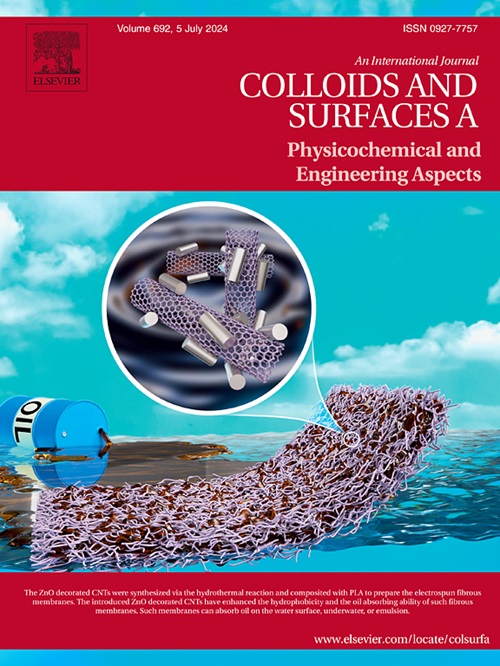具有路易斯酸碱性的 g-C3N4/PP-CD 异质结构促进光催化 CO2 还原成 CH3OH
IF 4.9
2区 化学
Q2 CHEMISTRY, PHYSICAL
Colloids and Surfaces A: Physicochemical and Engineering Aspects
Pub Date : 2024-10-31
DOI:10.1016/j.colsurfa.2024.135676
引用次数: 0
摘要
光催化还原二氧化碳以产生有价值的化学物质,有望在实现碳中和目标方面发挥重要作用。光生电子-空穴分离效率是决定光催化活性的因素之一。本文采用简便的机械搅拌法将含氧原卟啉的碳点(PP-CDs)负载在 g-C3N4 纳米片上,形成异质结构。g-C3N4/PP-CDs-3的导带电位为-1.31 eV,带隙为2.51 eV,在不添加任何光敏剂和牺牲剂的情况下,光照下甲醇产率达到357.5 μmol-g-1-h-1,是g-C3N4产率(162.1 μmol-g-1-h-1)的2.2倍,经过四个周期后,光催化活性保持不变。实验和表征结果表明,CO2 光催化还原甲醇性能的提高主要归功于可见光吸收和高路易斯酸碱性。此外,由于碳点的重组,为光生电子-空穴重组提供了立体阻碍,他的工作为构建高效光催化剂以实现 CO2 到 CH3OH 的转化提供了一种有前途的策略。本文章由计算机程序翻译,如有差异,请以英文原文为准。
g-C3N4/PP-CDs Heterostructure with Lewis acidity and alkalinity promoted photocatalytic CO2 reduction to CH3OH
It is expected that photocatalytic reduction of carbon dioxide to produce valuable chemicals play an important role in achieving carbon neutrality goals. Photogenerated electron-hole separation efficiency is one of the factors determining photocatalytic activity. Herein, carbon dots with oxygen-containing protoporphyrin (PP-CDs) were loaded on g-C3N4 nanosheets form a heterostructure by a facile mechanical stirring method. The g-C3N4/PP-CDs-3 has a conduction band potential of −1.31 eV and a bandgap of 2.51 eV, in the absence of any added photosensitizer and sacrificial agent under illumination, the methanol yield achieved 357.5 μmol·g−1·h−1, which is 2.2 times than that of g-C3N4 (162.1 μmol·g−1·h−1), after four cycles, the photocatalytic activity remained unchanged. Based on the experimental and characterizations results, it is indicated that the photocatalytic reduction performance of CO2 to methanol was improved mainly attributed to the visible light absorption and the high Lewis acidity and alkalinity. Furthermore, the steric hindrance was provided for photogenerated electron-hole recombination due to the recombination of carbon points his work offers a promising strategy for constructing efficient photocatalysts to achieve CO2 to CH3OH transformation.
求助全文
通过发布文献求助,成功后即可免费获取论文全文。
去求助
来源期刊
CiteScore
8.70
自引率
9.60%
发文量
2421
审稿时长
56 days
期刊介绍:
Colloids and Surfaces A: Physicochemical and Engineering Aspects is an international journal devoted to the science underlying applications of colloids and interfacial phenomena.
The journal aims at publishing high quality research papers featuring new materials or new insights into the role of colloid and interface science in (for example) food, energy, minerals processing, pharmaceuticals or the environment.

 求助内容:
求助内容: 应助结果提醒方式:
应助结果提醒方式:


